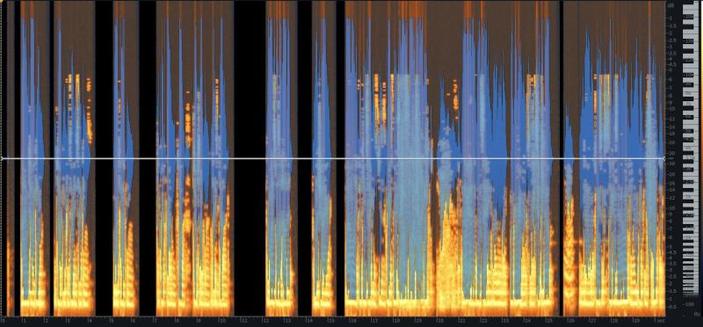「 #GNURadio is a free & #opensource software development toolkit that provides signal processing blocks to implement software radios. It can be used with readily-available low-cost external RF hardware to create software-defined radios, or without hardware in a simulation-like environment. It is widely used in research, industry, academia, government, and hobbyist environments to support both wireless communications research and real-world radio systems 」
Recent searches
Search options
#DSP
Guess what, @7nihilate just released this whole-ass #Rust #DSP that's meant for cleaning voice audio. Its specialty is making your voice recordings clear enough that they can sound good even if you highly compress them... but it's also a step to making better and more free hearing aid tech.
https://crates.io/crates/rustic_audio_tool
There's a GUI here:
https://github.com/brettpreston/Rustic_Audio
Last night, took a random sample from a discord I'm on and ran it through my DSP project to see what it would sound like.
Opened the resulting wav in RX9 and saw the wav looked mad; huge DC offset in the samples
Turns out the original sample had a small DC offset (0.03%) and time stretch + grains amplified it to 17%!
So, anyway, I've now got some DC offset filtering code aka a simple first order high pass to take out super low frequencies (sub-20hz or so) - problem solved
How To Read Scientific DSP Publications and Turn Them Into Code – Matthijs Hollemans – ADC 2024
https://www.youtube.com/watch?v=KdFQDnwav0Y
#coding #dsp #programming #SoftwareEngineering
Finally got around to making a nice thick chorus in Max/MSP (instead of just copying the single-delay one from the documentation). It's based on the Sony DPS-M7 Deca chorus and has 5 taps per channel, with complex panning of them on the output:
#dsp friends! you got tips on recreating the #synthesistechnology e560 #phaser mode in pd? is hilbert~ the same as an 8 stage phaser? probably no! do I run everything through 2x8 allpass filters followed by a hilbert~ to get that 90 degree quadrature? how to decide on allpass coefficients? how to phase shift by degree in the first place? where to even start? Julius O. Smith to the rescue!?
V1.0
PodcastPlugins is a set of Free and Open-Source speech-enhancement audio plugins for podcasters.
vst + vst3 + clap + LV2 + AU
Linux + macOS + Windows
Enjoy :)
Huge thanks to @falktx <3
@x42 @magnetophon @jkdb
Supported by @PrototypeFund
Aviary Audio Hamburger (Distortion Plugin) v0.5 VST3 CLAP AU LiNUX WiN MacOS [FREE]
The Usual Suspects Nodal Red 2x (DSP56300 Emulator) 1.4.3 VSTI/VSTI3/AU/CLAP/LV2 MultiOS + ROM’s [FREE]
https://www.youtube.com/watch?v=rBdzA7wtqSs
I made a #SuperTuxKart #montage video using Short-Time Fourier Transforms!
Be sure to read the pinned comment for details!
DSP and control theory tooters, how do you smooth a tach signal?
I'm measuring a sequence of tachometer pulses, and I want to turn that into a smoothed current speed number. Everything I know about DSP uses a fixed sampling interval, but these aren't fixed -- the interval is the signal.
This has to be a well known problem with well known solutions...
Thank you.
I first read Smith's "The #Scientist and #Engineer's Guide to #DSP" in the late 1990s, when it was published. I was ambivalent about its efficacy, especially considering that the title includes "engineer" but the pages contain almost no maths. I mean, just compare this book to Oppenheim's 1975 classic, "Digital Signal Processing", which I used to study DSP. Indeed, why compare at all.
But some years later, I loaned my copy of Smith's book to a #CS friend of mine who was trying to enter DSP through the programmer's doorway. And this book helped him a great deal, especially because it contains complete implementations of various algorithms—in BASIC.
It seems the traditional order of presentation of DSP, like introducing the \(z\)-domain in the first chapter as #EE textbooks do habitually, can be counterproductive to non-EE readers. That's probably why Smith introduces this topic in the final chapter.
Perspectives....
New release is here! Probably, the biggest one ever. Meet audio. Games now can create chiptunes like on #SNES or #GBA and apply on top of it some modern filters and effects.
Grab binaries for Linux and OS X here:
https://github.com/firefly-zero/firefly-emulator-bin/releases/tag/0.3.0
Read more about audio (and listen to some sine waves):
https://docs.fireflyzero.com/dev/audio/
We also improved the installation guide:
https://docs.fireflyzero.com/user/installation/
#Introduction and some made-up hashtags of my interests, which I will get wrong and then edit:
* #theoreticalPhysics #philosophy #maths
* #sff #writer
* #synthesizers #music #musicComposition #surgeSynth #surgeSynthTeam #dsp
* #digitalart #krita #digitalpainting #blender #photography #landscapes #architecture
* #gaming #VintageStory #tableTopGames #boardgames
* #gameDev #javaScript
I might occasionally post my creative explorations.



